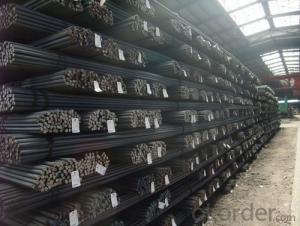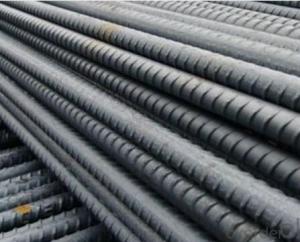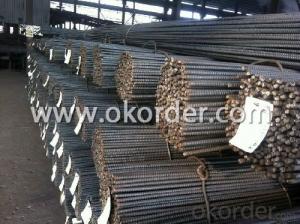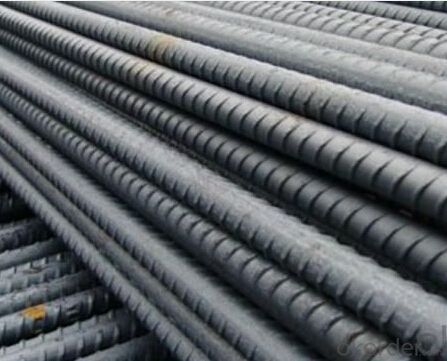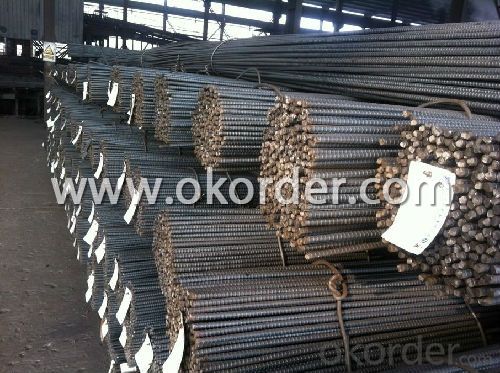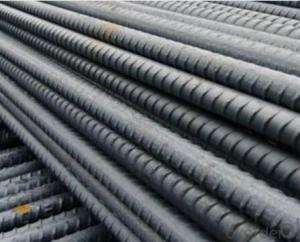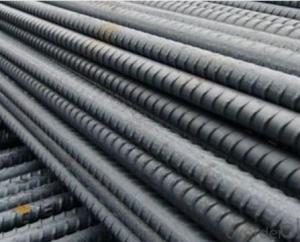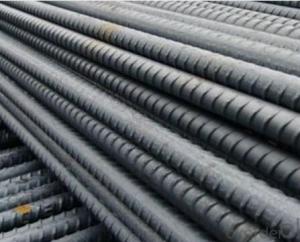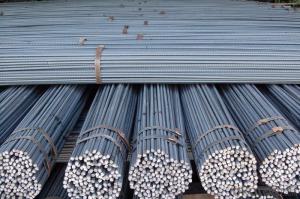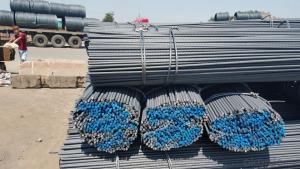HIGH QUALITY HOT ROLLED STEELDIN STANDARD REBAR
- Loading Port:
- Tianjin
- Payment Terms:
- TT OR LC
- Min Order Qty:
- 50 m.t.
- Supply Capability:
- 100000 m.t./month
OKorder Service Pledge
OKorder Financial Service
You Might Also Like
Product Description:
Specifications of Hot Rolled Steel Rebar:
The production process of Steel Rebar
1-Waling beam furnace 2-Roughing rolling group 3-Intermediate rolling train
4-Finishing rolling group 5-Water-cooling device 6-Walking beam cooler
7-Finishing equipment(including the cold scale shear,short feet collection system,
automatic counting device,bundling machine, collect bench)
Usage and Applications of Hot Rolled Steel Rebar:
Deformed bar is widely used in buildings, bridges, roads and other engineering construction. Big to highways, railways, bridges, culverts, tunnels, public facilities such as flood control, dam, small to housing construction, beam, column, wall and the foundation of the plate, deformed bar is an integral structure material. With the development of world economy and the vigorous development of infrastructure construction, real estate, the demand for deformed bar will be larger and larger..
Packaging & Delivery of Hot Rolled Steel Rebar:
Packaging Detail: products are packed in bundle and then shipped by container or bulk vessel, deformed bar is usually naked strapping delivery, when storing, please pay attention to moisture proof. The performance of rust will produce adverse effect.
Each bundle weight: 2-3MT, or as required
Payment terms: TT payment in advance or Irrevocable LC at sight.
Trade terms :FOB, CFR, CIF
Label:to be specified by customer, generally, each bundle has 1-2 labels
Note:
1. Our products are produced according to national standard (GB), if not, supply according to national standards (GB) or agreement as customer required.
2. Other Grade and Standard Deformed Steel Bar we can supply:
Grade: GR40/GR60, G460B/B500A/B500B/B500C,BST500S
Standard: ASTM, BS, DIN
The Minimum Order Quantity of these products is high, and need to be confirmed.
3. We can not only supply Deformed Steel Bar; if you need anything about building materials, please contact us for further information.
4. Please send us your detail specifications when inquire. We will reply to you as soon as possible. We sincerely hope we can establish a long stable business relationship.
- Q: What are the guidelines for the proper lap splicing of steel rebars?
- Here are different grammar and expressions for the given guidelines: 1. Lap Length: To achieve the proper overlapping of rebars, a minimum distance, known as the lap length, must be maintained. This distance is determined based on factors such as bar diameter, strength, and the type of structure. Engineering codes and standards generally specify the required lap lengths. 2. Cleanliness: Before commencing lap splicing, it is crucial to ensure that the rebars are free from any dirt, rust, oil, or other contaminants. The presence of foreign materials on the rebar surface can impede the bond between the overlapping bars. 3. Alignment: The rebars intended for splicing must be accurately aligned and parallel to each other. Any misalignment can result in a weak splice, compromising the structural integrity of the construction. 4. Overlapping: The length of overlap between the rebars should be sufficient to transfer loads effectively and maintain reinforcement continuity. It is imperative to adhere to the specified lap length to achieve the required strength and performance of the reinforced concrete structure. 5. Splice Configuration: The choice of lap splice configuration depends on the structural requirements and the specific design of the project. Commonly used configurations include end-to-end splicing, staggered splicing, and mechanical splices. The selection of the appropriate configuration should comply with relevant codes and standards. 6. Splice Preparation: Thorough cleaning and preparation of the rebars at the lap splice area are necessary. This involves removing any loose rust or scale from the bar surface and ensuring adequate bond length between the bars. 7. Lap Splice Placement: The lap splice should be positioned at the designated location within the concrete member. It is crucial to avoid placing the splice too close to the edge of the concrete element, as this may reduce the cover depth and impact the structure's durability. 8. Splice Length Variations: In situations where achieving the required lap length is not feasible due to space limitations or other restrictions, alternative methods such as mechanical splices or welded splices can be considered. However, it is essential to consult the project engineer or designer to ensure compliance with the appropriate guidelines. 9. Quality Control: The lap splicing process should be subject to proper quality control measures. This includes monitoring the lap splice length, ensuring accurate alignment, and conducting periodic inspections to identify any defects or deficiencies. It is important to note that the above guidelines serve as general recommendations, and the specific requirements for lap splicing may vary depending on the design specifications, construction codes, and local regulations. Therefore, it is always advisable to consult the project engineer or designer for precise guidelines applicable to a particular project.
- Q: How do steel rebars affect the durability of concrete in freeze-thaw cycles?
- Steel rebars can greatly enhance the durability of concrete in freeze-thaw cycles. When concrete is exposed to freezing and thawing conditions, it undergoes a cycle of expansion and contraction. During freezing, water inside the concrete pores freezes and expands, exerting pressure on the surrounding concrete matrix. This expansion can lead to cracks and deterioration of the concrete. However, the presence of steel rebars within the concrete can help mitigate these issues. Steel has a much lower coefficient of thermal expansion compared to concrete, which means it does not expand and contract as much with temperature changes. This property allows the steel rebars to absorb the stresses generated during freeze-thaw cycles, preventing significant damage to the concrete structure. Additionally, steel rebars also provide reinforcement to the concrete, increasing its overall strength and toughness. This reinforcement helps to distribute the stresses caused by freeze-thaw cycles more evenly throughout the concrete, reducing the likelihood of cracks forming or propagating. Furthermore, steel rebars act as a barrier against water penetration into the concrete. Moisture is one of the main factors that contribute to freeze-thaw damage. The steel rebars help to create a more impermeable concrete structure by reducing the size and quantity of cracks, preventing water from entering and causing further deterioration. In summary, steel rebars play a crucial role in enhancing the durability of concrete in freeze-thaw cycles. Their ability to absorb stresses, reinforce the concrete, and prevent water penetration significantly reduces the potential for damage and extends the lifespan of the concrete structure.
- Q: Can steel rebars be used in modular bridge construction?
- Modular bridge construction utilizes steel rebars, also known as reinforcing bars, to enhance the structural integrity of precast concrete elements. This construction method offers efficiency and cost-effectiveness. Precast elements are fabricated in a controlled environment, ensuring consistent production and high-quality outcomes. The steel rebars are accurately incorporated into the elements during manufacturing, eliminating the need for on-site rebar installation. Steel rebars play a crucial role in withstanding the loads and stresses experienced by bridges. They distribute the load evenly, preventing concrete elements from cracking or failing. By incorporating steel rebars into modular bridge construction, the durability and longevity of the bridge structure are ensured. The integration of steel rebars in the modular bridge design allows for flexibility and customization. Different sizes and configurations of rebars can be used to meet the specific requirements of each bridge project, optimizing its structural performance. In summary, steel rebars are extensively utilized in modular bridge construction due to their ability to reinforce, strengthen, and enhance the durability of precast concrete elements. This approach offers a cost-effective and efficient construction process while maintaining the structural integrity of the bridge.
- Q: What are the considerations for using epoxy-coated steel rebars?
- When using epoxy-coated steel rebars, there are several considerations to keep in mind. Firstly, it is important to ensure that the coating is properly applied and has adhered well to the rebar surface to provide effective protection against corrosion. Secondly, the epoxy coating should be resistant to chemicals commonly found in the construction environment. Additionally, the handling and storage of epoxy-coated rebars should be done with care to avoid any damage to the coating. It is also crucial to follow the recommended installation practices to prevent any damage or delamination of the epoxy coating during the concrete pouring process. Lastly, periodic inspection and maintenance should be carried out to ensure the longevity of the epoxy-coated steel rebars and to address any potential damages or breaches in the coating.
- Q: What are the common types of steel rebars used in bridge construction?
- The common types of steel rebars used in bridge construction are typically hot-rolled, deformed, and epoxy-coated rebars.
- Q: Can steel rebars be used in hotel construction?
- Yes, steel rebars can be used in hotel construction. Steel rebars are commonly used as reinforcement within concrete structures to enhance their strength and durability. In hotel construction, steel rebars are often incorporated into the foundation, columns, beams, and slabs to provide structural integrity and support the overall load-bearing capacity of the building.
- Q: Are steel rebars suitable for use in industrial structures?
- Industrial structures can benefit from the use of steel rebars. These reinforcing bars, also known as steel rebars, are frequently used in the construction industry to enhance the strength and stability of concrete structures. Crafted from high-strength steel, they possess exceptional tensile strength, making them perfect for fortifying concrete in industrial structures that encounter hefty loads, vibrations, or other dynamic forces. Steel rebars also boast good ductility, enabling them to endure bending without fracturing. This is a crucial characteristic in industrial structures that demand high structural integrity. Moreover, steel rebars display commendable resistance to corrosion, a vital quality in industrial environments where exposure to moisture, chemicals, or other corrosive agents is common. In summary, steel rebars serve as a dependable and long-lasting option for reinforcing industrial structures, preserving their structural stability and safety over time.
- Q: Can steel rebars be used in structures with high resistance to earthquakes?
- Yes, steel rebars can be used in structures with high resistance to earthquakes. Steel rebars are commonly used in seismic-resistant structures due to their high tensile strength and ductility. They are able to absorb and dissipate the energy generated during an earthquake, providing reinforcement and stability to the structure. Additionally, modern construction techniques and design codes ensure that steel rebars are properly integrated into earthquake-resistant structures to enhance their overall resilience.
- Q: Are steel rebars suitable for use in high-traffic areas like bridges?
- Yes, steel rebars are suitable for use in high-traffic areas like bridges. Steel rebars provide exceptional strength and durability, making them ideal for withstanding heavy loads and frequent use. Additionally, steel rebars offer excellent resistance to corrosion, ensuring the longevity and structural integrity of bridges in high-traffic areas.
- Q: Are steel rebars resistant to chemical attacks?
- Yes, steel rebars are generally resistant to chemical attacks. The high strength and durability of steel make it less susceptible to damage from various chemicals, including acids and alkalis. However, certain aggressive chemicals or environments may cause corrosion over time, which can be mitigated by applying protective coatings or using corrosion-resistant alloys.
Send your message to us
HIGH QUALITY HOT ROLLED STEELDIN STANDARD REBAR
- Loading Port:
- Tianjin
- Payment Terms:
- TT OR LC
- Min Order Qty:
- 50 m.t.
- Supply Capability:
- 100000 m.t./month
OKorder Service Pledge
OKorder Financial Service
Similar products
Hot products
Hot Searches
Related keywords
